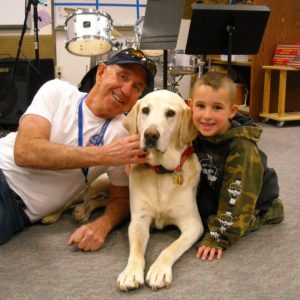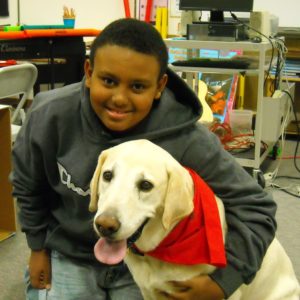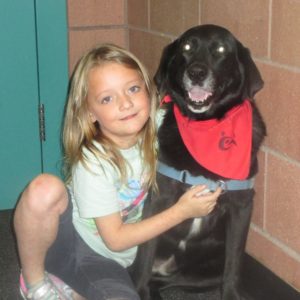 Wayne Boyles may be waiting on the sideline during the Covid-19 pandemic to get back to volunteering at local schools, but he and his therapy dogs are remembered by students and teachers.
Wayne Boyles may be waiting on the sideline during the Covid-19 pandemic to get back to volunteering at local schools, but he and his therapy dogs are remembered by students and teachers.
For several years, Boyles has served as a Human-Animal Bond in Colorado – HABIC volunteer team with two animal partners. He worked with his first dog in the HABIC program, a yellow Labrador Retriever named Rex, until May 2016.
Boyles then trained and certified his black Labrador Retriever Lacy in September 2016, to continue volunteering with school students in Fort Collins. Boyles has made a difference at Laurel Elementary School and Lincoln Middle School.
“Watching my dogs interact and bring warmth and happiness to people is rewarding,” said Boyles. “When children working on issues improve, that’s rewarding.”
School-based therapy dogs show a special connection with young people
 Boyles started volunteering with Rex, who is now retired, in 2013 after a number of people recommended the HABIC community outreach program. “He was a fast learner who loved to work,” said Boyles. “Rex felt others’ moods and emotions and was very responsive to their needs.”
Boyles started volunteering with Rex, who is now retired, in 2013 after a number of people recommended the HABIC community outreach program. “He was a fast learner who loved to work,” said Boyles. “Rex felt others’ moods and emotions and was very responsive to their needs.”
Boyles noticed Rex loved meeting new people, especially children and youth.
“Rex always enjoyed children. He often left me to play with kids at the dog park or at Horsetooth reservoir,” said Boyles. “People commented that Rex would be a great therapy dog. I thought Rex was special in that aspect and believed he might really help kids.”
After completing certification with HABIC, Boyles and Rex began working with Leah Roberts, the lead school counselor at Laurel Elementary School of Arts and Technology in Poudre School District.
 “I have had the privilege of teaming up with Wayne and his therapy dogs for the past eight years,” said Roberts, who remembers Rex as “so calm, loving, easy going, comfortable and confident. Rex enjoyed snuggles and moments to just be with the kiddos.”
“I have had the privilege of teaming up with Wayne and his therapy dogs for the past eight years,” said Roberts, who remembers Rex as “so calm, loving, easy going, comfortable and confident. Rex enjoyed snuggles and moments to just be with the kiddos.”
Rex was also very trainable. Boyles remembered how his dog demonstrated this quality from the very beginning of their relationship.
“The first day I had Rex at home, I took him outside with me to get the morning newspaper,” said Boyles. “The next morning he quickly ran out the open door, grabbed the newspaper and ran back into the house with it, dropping the paper at my feet. He did this every day until he was slowed by arthritis.”
After Boyles retired Rex in 2016, he trained Lacy, a rescue dog who was given to him by his daughter.
“Lacy was a natural to pick up where Rex left off and fits with HABIC very well,” said Boyles. “She has a very sweet personality. She bonds very quickly with children and others, and loves working. It is the highlight of her week.”
Partnerships key to volunteering with therapy dogs at schools
Although this past year was disrupted by the pandemic, Boyles and his dogs made an impression on school students and staff that holds the hope for their return.
“They were always in our hearts and thoughts,” said Roberts. “Students continued to ask about them and communicated their eagerness to see them soon.”
When working in schools, the partnership between the volunteer, the therapy dog, and the school counselor or social worker is key to the success of the therapeutic process for students.
“Together, we identify individual goals, explore expectations of the program, communicate with staff and families, monitor and review progress, build a trusting relationship, teach commands, and ensure all parties involved are safe and having fun,” said Roberts.
 Roberts says Boyles’ current volunteer partner Lacy is “full of energy and life, yet so gentle and sweet. Lacy is willing to try anything and shows great excitement when seeing the kiddos.”
Roberts says Boyles’ current volunteer partner Lacy is “full of energy and life, yet so gentle and sweet. Lacy is willing to try anything and shows great excitement when seeing the kiddos.”
Both Rex and Lacy were selected to work in schools because of these qualities, in addition to other factors, according to HABIC’s animal trainer and volunteer coordinator Kate Miller.
“When we are placing volunteers in schools, we are looking for dogs who are ‘busy bees,’” said Miller. “They love learning new skills and have a high drive to work. We are also looking for dogs who are extremely tolerant of all types of touch.”
“The handler and school professional begin a long working relationship,” Miller said, “partnering together to accomplish the animal-assisted therapies.”
Volunteer teams at Laurel Elementary work with individual students weekly for up to two months. At the end of the program, each student is given the opportunity to showcase what they have learned.
 “Parents and teachers are invited,” Roberts said, “and our students in the program perform some of the commands [with their therapy dog] in front of the entire class. This brings so much joy to all involved. There is a sense of pride and accomplishment for our students who have worked so hard.”
“Parents and teachers are invited,” Roberts said, “and our students in the program perform some of the commands [with their therapy dog] in front of the entire class. This brings so much joy to all involved. There is a sense of pride and accomplishment for our students who have worked so hard.”
“This program helps students learn how to communicate their needs, take risks, accept feedback, increase social skills, improve attention skills, control emotions, highlight their strengths, and acknowledge areas for growth,” added Roberts.
The partnership between Boyles and Roberts in making these moments possible for local school students is part of the success.
“I have so enjoyed Wayne’s calm and caring demeanor,” said Roberts. “He always comes in with a smile, ready to work. His laugh is contagious. I appreciate his work ethic and his willingness.”
Expanding the impact of the human-animal bond in the community
Boyles has not only made an impression on students. The teachers and staff have also benefitted from their visits.
“Our entire Laurel community enjoys seeing Wayne and his dog team,” said Roberts. “In fact, multiple staff keep dog treats around just for Lacy. This team was a huge support for us when we lost a staff member. Wayne and Lacy were there for us to be the light we needed during this grieving time.”
In addition to working with school students on a weekly basis, and helping school staff, over the years Boyles and his therapy dogs have worked at CSU during midterms and finals to help college students de-stress.
 For Boyles, the commitment of serving as a therapy dog team with both Rex and Lacy has been worthwhile for the results of “helping adults and children heal from difficult situations and bringing comfort to others.”
For Boyles, the commitment of serving as a therapy dog team with both Rex and Lacy has been worthwhile for the results of “helping adults and children heal from difficult situations and bringing comfort to others.”
“I have not done a lot but watching my dogs make people feel better and overcome difficult times is rewarding,” said Boyles. “HABIC is a worthwhile program which allows one to give back to the community and improve the lives of others.”
What Boyles and his dogs accomplished for students through volunteering has made a difference.
“It can be as simple as learning how to introduce yourself, or building confidence and learning how to control one’s impulses by staying calm and in control” said Roberts of her students. “You see changes during each session, and these are often carried over into the classroom, with hopes they will carry over into the real world.”
 About Human-Animal Bond in Colorado
About Human-Animal Bond in Colorado
Founded in 1993, Human-Animal Bond in Colorado (HABIC) is a center in the School of Social Work, part of CSU’s College of Health and Human Sciences. HABIC’s mission is to improve the quality of life for people of all ages through the therapeutic benefits of companion animals, with particular focus in the areas of community outreach, teaching, and research.